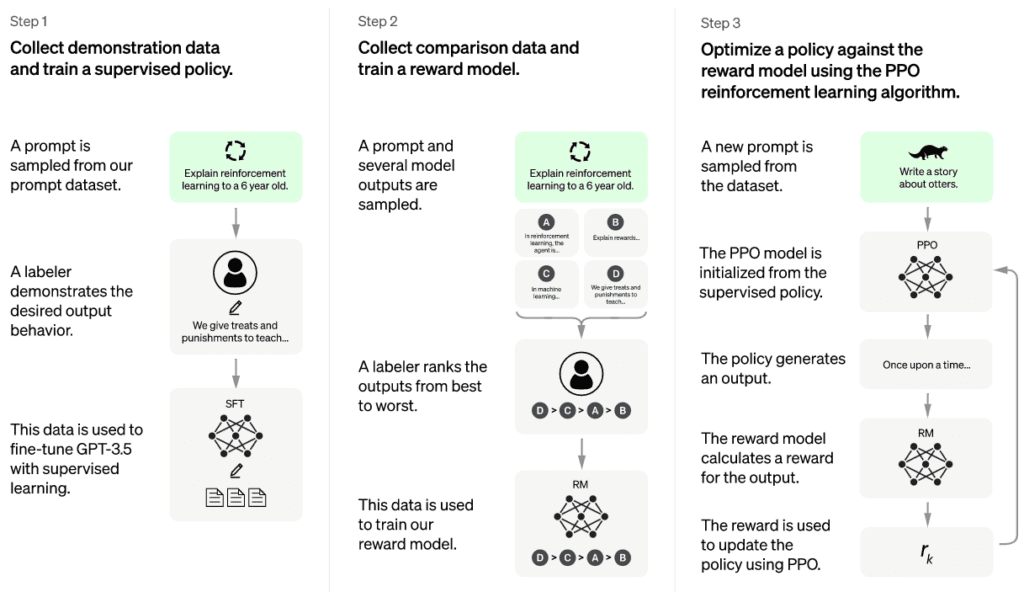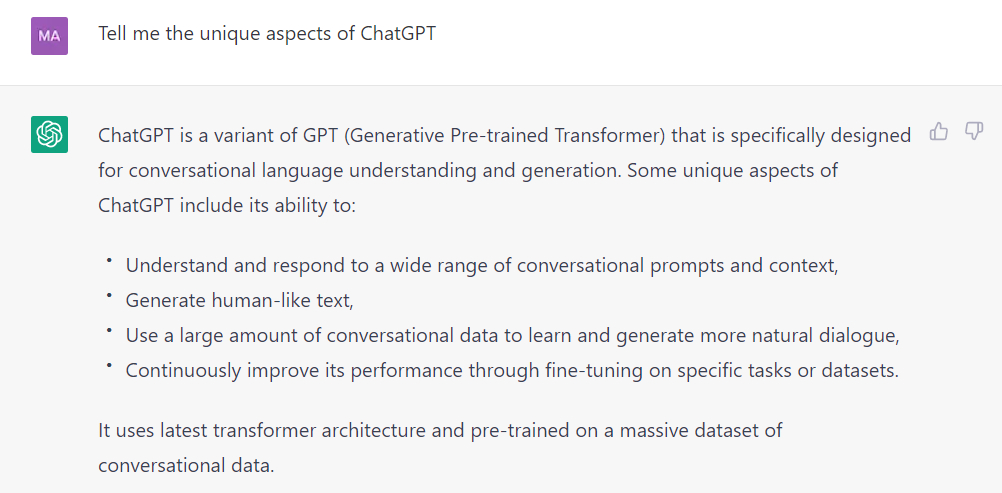ChatGPT was launched in November 2022. Since then, OpenAI’s GPT-3 tool, ChatGPT, has been making headlines and featuring heavily on people’s social media feeds. But what is it, really? How does it work? And most importantly, what’s the hype around ChatGPT all about?
Let’s deep dive to answer all the questions.
What is GPT-3 and ChatGPT?
GPT-3 stands for Generative Pre-Trained Transformer 3, a family of advanced language processing models developed by OpenAI. It is an incredibly powerful language-processing artificial intelligence model with 175 billion parameters.
It’s a kind of neural network architecture comprising various layers of interconnected nodes. Every node in the network processes a particular aspect of the input text (syntax, overall meaning, context, etc.). All the nodes work together to produce grammatically correct and coherent responses. A critical feature of GPT-3 is its ability to learn from vast amounts of data.
You can use GPT-3 to generate human-like text. Moreover, it is involved in developing texts for chatbot applications, language modeling, and language translation. However, its most popular use today is the creation of ChatGPT – a state-of-the-art chatbot making waves around the world these days for its accurate responses and wide application.
ChatGPT is the large language model developed by OpenAI and employed in language processing tasks like language translation and text generation. It is based on the GPT 3.5 neural network architecture, one of the most advanced AI language models available today.
You can employ it to generate human-like text responses to text inputs. It follows a dialogue format and interacts in a conversational manner with users. Its dialogue format enables it to respond to follow-up questions, acknowledge its faults, question false premises, and deny inappropriate user demands or requests.
Moreover, its conversational way of interaction means you can use it for a wide range of purposes, including building chatbots for delivering superior customer service, generating answers to questions on various online platforms, and even creating personalized social media content for marketing purposes.
How Does it Work?
OpenAI trains ChatGPT to follow the instruction in a prompt and give an elaborate response to it. They used the Reinforcement Learning from Human Feedback (RHLF) method to train it.
The initial model was trained through supervised fine-tuning, where human AI trainers played the roles of both users and AI assistants. Trainers were given model-written recommendations to help them formulate their responses.
They also created a reward model for reinforcement learning using comparison data comprising two or more model responses ranked according to their quality. OpenAI collected this data by utilizing the conversations between the AI chatbots and the human AI trainers. The developers at OpenAI chose a random model-written response, examined alternative responses, and asked the AI trainers to rank them. They used these models to refine the language processing model in ChatGPT using Proximal Policy Optimization, a set of reinforcement learning algorithms that are very convenient to implement and perform better than other algorithms.
Here’s a diagram explaining how ChatGPT works:

Both ChatGPT and GPT 3.5 were trained using Azure AI supercomputing infrastructure.
Let’s discuss the use cases and limitations of ChatGPT and the reasons for the hype surrounding it.
Use Cases of ChatGPT
While there are many ways to use ChatGPT, some of its primary applications include the following:
- Text Generation – You can use ChatGPT to generate humanistic text replies to input prompts. This allows you to use the bot for multiple purposes, as mentioned above, including customer service, social media posting and marketing, and answering questions on forums and blogs.
- Translation – You can also employ ChatGPT for language translation. All you need to do is give the model a text prompt in one language and inform it about the target language. The model will automatically produce a precise and coherent translation of your text.
- Summarization – Students and researchers, besides others, can use ChatGPT to summarize a long document. This helps users get an overview of the document without having to go through all of it, thus saving time.
- Sentiment Analysis – Another great application of ChatGPT is sentiment analysis. You can use the AI-powered bot to analyze the sentiment of a piece of text to help you understand its emotion and overall tone. You can then use it to refine your customer service by understanding the tone of the customer feedback.
ChatGPT Features That Drive Its Popularity
There are multiple reasons why ChatGPT is gaining so much traction these days. Here are some of the significant reasons for its popularity:
- Large size – ChatGPT belongs to a set of technologies called large language models. OpenAI has trained it using vast amounts of data, allowing it to become really good at language processing tasks.
- Human-like replies – ChatGPT’s claim to fame is undoubtedly due to its ability to render human-like responses to prompts. These responses are highly relevant and enable the users to trust the chatbot for providing accurate language translations, summarizations, and text generation.
- Adaptability & versatility – Another critical ChatGPT feature is its capability to adapt to different situations and contexts. From learning quantum mechanics to generating content for social media posts, ChatGPT is versatile enough to do it all for its users.
When asked about its unique aspects, here’s what the viral bot had to say about itself:

All these features make ChatGPT an excellent tool for natural language processing NLP tasks. However, as with any other machine learning model, ChatGPT also has its limitations.
Let’s look at these.
ChatGPT Limitations
Here are some of the major limitations of ChatGPT:
- Data dependency – As a machine learning model, OpenAI has trained ChatGPT on a tremendous amount of text data. Thus, the quality and precision of its responses depend on the versatility and accuracy of the data fed to it. If the data provided to it is not diverse enough or accurate, it will render erroneous and inappropriate responses.
- Deficient understanding – Although you can use ChatGPT to generate coherent and accurate responses to prompts, it does not possess a profound knowledge of our culture and world similar to that of a human. Therefore, the bot might not comprehend abstract questions or the context of your prompt, resulting in inadequate responses.
- Bias – The most significant limitation of – as well as concern regarding – ChatGPT is its tendency to produce biased responses. The bias in its responses is due to the bias in the data or algorithms it uses and can relate to sex, gender, religion, ethnicity, etc. Thus, users are advised to bear this fact in mind while using the chatbot.
- Technical errors – Users can encounter errors while using ChatGPT due to technical reasons or resource limitations.
Apart from these limitations, ChatGPT also possesses limited knowledge of the world and the major events that took place in it post-2021. Moreover, the model can generate incorrect information in response to your prompt or misconstrue what you are trying to ask of it. You can also overwhelm it by adding too many factors to your prompt.
Conclusion
Despite having its limitations, ChatGPT is an incredible tool for executing natural language processing tasks. Although it may give incorrect responses from time to time, it is a machine-learning model that continuously learns and improves itself.
Moreover, ChatGPT has been trained with data while keeping legal and ethical aspects of responses in mind. Its responses are often geared towards providing answers that do not hurt people’s sentiments or advise outright illegal courses of action. Similarly, it is capable of remembering the rules you set for it and keeping track of existing conversations.
To sum it up, ChatGPT is a fantastic AI-powered tool that is fast gaining the attention of individuals and companies alike. Microsoft’s plans to invest a whopping $10 billion in OpenAI is a testament to its popularity.
Do you wish to create a specific ChatGPT use case tailored to your business needs? Contact us at [email protected] for further information.

